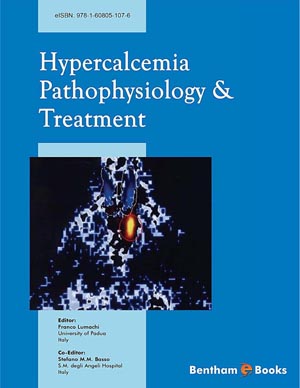Abstract
Hypercalcemia is a relatively common disorder. Primary hyperparathyroidism and malignancy-associated hypercalcemia (MAH) are responsible for more than 90% of all causes of hypercalcemia. General measures of treatment include rehydration and loop diuretics, when renal insufficiency or heart failure is associated. Calcitonin is indicated for the short-term control of severe hypercalcemia, while bisphosphonates are required in the long-term management. The antireabsorptive action of bisphosphonates has been considered the most effective in the disorders characterized by an excessive bone resorption. Both clodronate and pamidronate have been widely used in the past. Recently controlled clinical trials demonstrated the superiority of zoledronate compared with previous treatments. The use of calcimimetic agents has been recently introduced to control hypercalcemia in selected cases of primary hyperparathyroidism. They are used when patients do not meet surgical criteria or surgery is not possible or accepted. Recent studies on cancer-induced bone disease have highlighted the role of receptor activator of nuclear factor-κ ligand (RANKL) as a critical effector of skeletal complications of malignancy. RANKL inhibitors may reduce bone resorption in patients with bone metastases and multiple myeloma. Malignancyassociated hypercalcemia is broadly divided into two categories: humoral MAH and osteolytic MAH. The former refers to the paraneoplastic release of humoral factors, mainly parathyroid hormone-related peptide (PTHrP). A humanized monoclonal antibody against human PTHrP has been generated. It is able to neutralize the PTHrP effects, reducing hypercalcemia in human tumor xenograft animal models.






















